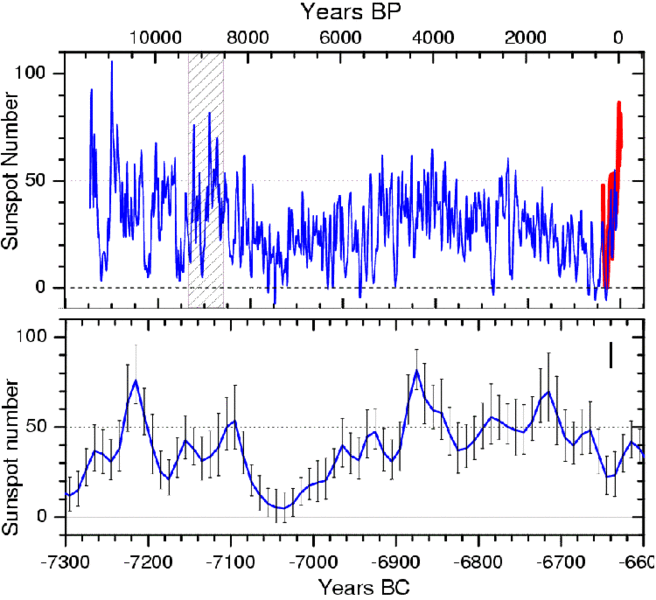The Sun is more active now than over the last 8000 years
An international team of scientists has reconstructed the Sun's activity over the last 11 millennia and forecasts decreased activity within a few decades
The activity of the Sun over the last 11,400 years, i.e., back to the end of the last ice age on Earth, has now for the first time been reconstructed quantitatively by an international group of researchers led by Sami K. Solanki from the Max Planck Institute for Solar System Research (Katlenburg-Lindau, Germany). The scientists have analyzed the radioactive isotopes in trees that lived thousands of years ago. As the scientists from Germany, Finland, and Switzerland report in the current issue of the science journal "Nature" from October 28, one needs to go back over 8,000 years in order to find a time when the Sun was, on average, as active as in the last 60 years. Based on a statistical study of earlier periods of increased solar activity, the researchers predict that the current level of high solar activity will probably continue only for a few more decades.

A large sunspot observed on the Sun in early September 2004. The field of view encompasses around 45,000 by 30,000 km of the Sun’s surface - the entire earth would fit into the area several times over. Sunspots appear dark because the strong magnetic field in the them suppresses the transport of energy through gas flow. In the central dark area of the sunspot (umbra) the magnetic field is perpendicular to the surface, whereas in the lighter coloured periphery (penumbra) the magnetic field is largely horizontal to the surface. The image was captured by Vasily Zakharov with a one-meter solar telescope on the island of La Palma. The telescope is operated by the Institute for Solar Physics of the Royal Swedish Academy of Sciences.
© Max Planck Institute for Solar System Research
A large sunspot observed on the Sun in early September 2004. The field of view encompasses around 45,000 by 30,000 km of the Sun’s surface - the entire earth would fit into the area several times over. Sunspots appear dark because the strong magnetic field in the them suppresses the transport of energy through gas flow. In the central dark area of the sunspot (umbra) the magnetic field is perpendicular to the surface, whereas in the lighter coloured periphery (penumbra) the magnetic field is largely horizontal to the surface. The image was captured by Vasily Zakharov with a one-meter solar telescope on the island of La Palma. The telescope is operated by the Institute for Solar Physics of the Royal Swedish Academy of Sciences.
© Max Planck Institute for Solar System Research
The research team had already in 2003 found evidence that the Sun is more active now than in the previous 1000 years. A new data set has allowed them to extend the length of the studied period of time to 11,400 years, so that the whole length of time since the last ice age could be covered. This study showed that the current episode of high solar activity since about the year 1940 is unique within the last 8000 years. This means that the Sun has produced more sunspots, but also more flares and eruptions, which eject huge gas clouds into space, than in the past. The origin and energy source of all these phenomena is the Sun's magnetic field.
Since the invention of the telescope in the early 17th century, astronomers have observed sunspots on a regular basis. These are regions on the solar surface where the energy supply from the solar interior is reduced owing to the strong magnetic fields that they harbour. As a consequence, sunspots are cooler by about 1,500 degrees and appear dark in comparison to their non-magnetic surroundings at an average temperature of 5,800 degrees. The number of sunspots visible on the solar surface varies with the 11-year activity cycle of the Sun, which is modulated by long-term variations. For example, there were almost no sunspots seen during the second half of the 17th century.
For many studies concerning the origin of solar activity and its potential effect on long-term variations of Earth's climate, the interval of time since the year 1610, for which systematic records of sunspots exist, is much too short. For earlier times the level of solar activity must be derived from other data. Such information is stored on Earth in the form of "cosmogenic" isotopes. These are radioactive nuclei resulting from collisions of energetic cosmic ray particles with air molecules in the upper atmosphere. One of these isotopes is C-14, radioactive carbon with a half life of 5730 years, which is well known from the C-14 method to determine the age of wooden objects. The amount of C-14 produced depends strongly on the number of cosmic ray particles that reach the atmosphere. This number, in turn, varies with the level of solar activity: during times of high activity, the solar magnetic field provides an effective shield against these energetic particles, while the intensity of the cosmic rays increases when the activity is low. Therefore, higher solar activity leads to a lower production rate of C-14, and vice versa.
By mixing processes in the atmosphere, the C-14 produced by cosmic rays reaches the biosphere and part of it is incorporated in the biomass of trees. Some tree trunks can be recovered from below the ground thousands of years after their death and the content of C-14 stored in their tree rings can be measured. The year in which the C-14 had been incorporated is determined by comparing different trees with overlapping life spans. In this way, one can measure the production rate of C-14 backward in time over 11,400 years, right to the end of the last ice age. The research group have used these data to calculate the variation of the number of sunspots over these 11,400 years. The number of sunspots is a good measure also for the strength of the various other phenomena of solar activity.
The method of reconstructing solar activity in the past, which describes each link in the complex chain connecting the isotope abundances with the sunspot number with consistent quantitative physical models, has been tested and gauged by comparing the historical record of directly measured sunspot numbers with earlier shorter reconstructions on the basis of the cosmogenic isotope Be-10 in the polar ice shields. The models concern the production of the isotopes by cosmic rays, the modulation of the cosmic ray flux by the interplanetary magnetic field (the open solar magnetic flux), as well as the relation between the large-scale solar magnetic field and the sunspot number. In this way, for the first time a quantitatively reliable reconstruction of the sunspot number for the whole time since the end of the last ice age could be obtained.

Top: Reconstructed sunspot activity (10 year average) for the last 11,400 years based on C-14 data (blue curve) and the directly observed historical sunspot data since 1610 (red curve). The reliable C-14 data ends around the year 1900 so that the sharp increase in sunspot activity in the 20th century does not appear in the graph. The reconstruction shows clearly that a comparable period of high sunspot activity previously existed over 8000 years ago. Below: An enlarged section of the upper graph (hatched area) with several episodes of higher sun activity; comparable to the 20th century.
© Max Planck Institute for Solar System Research
Top: Reconstructed sunspot activity (10 year average) for the last 11,400 years based on C-14 data (blue curve) and the directly observed historical sunspot data since 1610 (red curve). The reliable C-14 data ends around the year 1900 so that the sharp increase in sunspot activity in the 20th century does not appear in the graph. The reconstruction shows clearly that a comparable period of high sunspot activity previously existed over 8000 years ago. Below: An enlarged section of the upper graph (hatched area) with several episodes of higher sun activity; comparable to the 20th century.
© Max Planck Institute for Solar System Research
Because the brightness of the Sun varies slightly with solar activity, the new reconstruction indicates also that the Sun shines somewhat brighter today than in the 8,000 years before. Whether this effect could have provided a significant contribution to the global warming of the Earth during the last century is an open question. The researchers around Sami K. Solanki stress the fact that solar activity has remained on a roughly constant (high) level since about 1980 - apart from the variations due to the 11-year cycle - while the global temperature has experienced a strong further increase during that time. On the other hand, the rather similar trends of solar activity and terrestrial temperature during the last centuries (with the notable exception of the last 20 years) indicates that the relation between the Sun and climate remains a challenge for further research.
from Hacker News https://ift.tt/2pHG0Xp
No comments:
Post a Comment
Note: Only a member of this blog may post a comment.